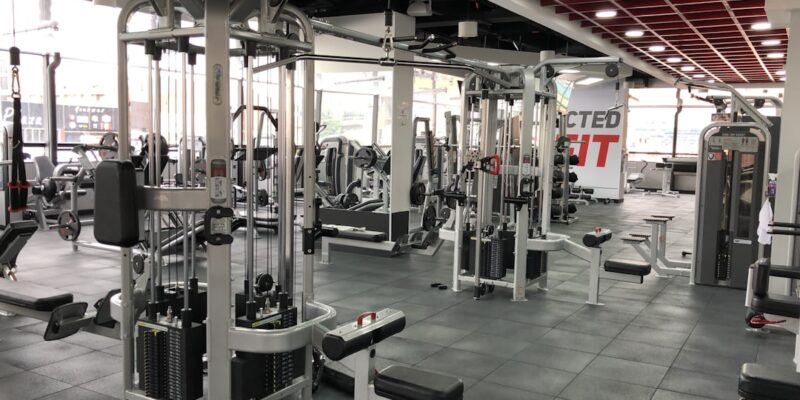
Beginner’s Guide to Effective Workouts
Exercise and fitness play a crucial role in maintaining a healthy lifestyle. Regular physical activity not only helps to improve our physical health but also has numerous mental benefits. In today’s sedentary world, where technology has made our lives more convenient but less active, it is important to understand the importance of exercise and make it a priority in our lives. This article will delve into the various aspects of exercise and fitness, including the benefits, setting realistic goals, choosing the right workout routine, incorporating different types of exercises, maximizing workouts with proper form and technique, creating a balanced workout schedule, staying motivated and consistent, and tracking progress.
Key Takeaways
- Exercise is important for overall health and well-being.
- Setting realistic fitness goals helps to stay motivated and consistent.
- Choosing the right workout routine and building a strong foundation with basic exercises is crucial.
- Cardiovascular exercise is important for optimal health.
- Strength training has numerous benefits and proper form and technique is key.
Understanding the Importance of Exercise
Exercise is not just about losing weight or building muscles; it has a wide range of physical and mental benefits. Regular physical activity helps to improve cardiovascular health, strengthen bones and muscles, enhance flexibility and balance, boost the immune system, and reduce the risk of chronic diseases such as heart disease, diabetes, and certain types of cancer. Exercise also plays a crucial role in maintaining mental well-being by reducing stress, anxiety, and depression. It improves mood, boosts self-confidence, enhances cognitive function, and promotes better sleep.
On the other hand, leading a sedentary lifestyle can have detrimental effects on our health. Sitting for long periods of time can lead to weight gain, muscle weakness, poor posture, and increased risk of chronic diseases. Lack of physical activity can also negatively impact mental health by increasing the risk of depression and anxiety. Therefore, it is important to incorporate regular exercise into our daily routine to reap the numerous benefits it offers.
Setting Realistic Fitness Goals
Setting realistic fitness goals is essential for long-term success. It is important to set achievable goals that are specific, measurable, attainable, relevant, and time-bound (SMART). Setting unrealistic goals can lead to frustration and demotivation. Start by assessing your current fitness level and identifying areas that you would like to improve. Set small, achievable goals that can be gradually increased over time. For example, if your goal is to lose weight, start by aiming to lose 1-2 pounds per week rather than setting an unrealistic goal of losing 10 pounds in a week.
It is also important to set goals that are relevant to your lifestyle and interests. Choose activities that you enjoy and are more likely to stick with in the long run. If you don’t enjoy running, don’t force yourself to do it. Find activities that you find enjoyable and incorporate them into your fitness routine. This will make it easier to stay motivated and consistent.
Choosing the Right Workout Routine
| Workout Routine | Benefits | Duration | Intensity | Equipment Needed |
|---|---|---|---|---|
| Cardiovascular | Improves heart health, burns calories, increases endurance | 30-60 minutes | Moderate to high | Treadmill, elliptical, stationary bike |
| Strength Training | Builds muscle, increases metabolism, improves bone density | 30-60 minutes | High | Dumbbells, resistance bands, weight machines |
| Pilates | Improves flexibility, strengthens core, reduces stress | 45-60 minutes | Low to moderate | Pilates reformer, mat |
| Yoga | Reduces stress, improves flexibility, strengthens muscles | 60-90 minutes | Low to moderate | Yoga mat, blocks, straps |
Choosing the right workout routine is crucial for achieving your fitness goals. There are various factors to consider when selecting a workout routine, including your fitness level, goals, preferences, and time availability. It is important to choose a routine that is challenging but not overwhelming. If you are a beginner, start with a basic routine and gradually increase the intensity as you become more comfortable.
There are different types of workouts that target different aspects of fitness. Strength training helps to build muscle strength and endurance, while cardiovascular exercise improves cardiovascular health and burns calories. High-intensity interval training (HIIT) combines both strength training and cardiovascular exercise for maximum results. It is important to incorporate a variety of exercises into your routine to target different muscle groups and prevent boredom.
Building a Strong Foundation with Basic Exercises
Building a strong foundation with basic exercises is essential for any fitness journey. Basic exercises such as squats, push-ups, lunges, and planks help to build strength, improve posture, and increase stability. These exercises target multiple muscle groups and provide a solid foundation for more advanced exercises.
When performing basic exercises, it is important to focus on proper form and technique. This not only ensures maximum effectiveness but also reduces the risk of injury. Start with lighter weights or bodyweight exercises and gradually increase the intensity as you become more comfortable. If you are unsure about proper form, consider working with a personal trainer who can guide you and provide feedback.
Incorporating Cardiovascular Exercise for Optimal Health
Cardiovascular exercise, also known as aerobic exercise, is an important component of any fitness routine. It helps to improve cardiovascular health, increase endurance, burn calories, and reduce the risk of chronic diseases. Cardio exercises include activities such as running, swimming, cycling, dancing, and brisk walking.
To incorporate cardiovascular exercise into your routine, aim for at least 150 minutes of moderate-intensity aerobic activity or 75 minutes of vigorous-intensity aerobic activity per week. You can break it down into smaller sessions throughout the week if needed. It is important to choose activities that you enjoy and are more likely to stick with in the long run. Mix up your cardio routine to prevent boredom and challenge different muscle groups.
The Benefits of Strength Training
Strength training is often overlooked but plays a crucial role in overall fitness. It helps to build muscle strength and endurance, increase bone density, improve posture, boost metabolism, and enhance athletic performance. Strength training exercises include weightlifting, resistance band exercises, bodyweight exercises, and using weight machines.
Incorporating strength training into your routine can be as simple as using dumbbells or resistance bands at home or joining a gym to access weight machines. Start with lighter weights or resistance and gradually increase the intensity as you become stronger. Aim for at least two days of strength training per week, targeting all major muscle groups.
Maximizing Your Workouts with Proper Form and Technique
Proper form and technique are essential for maximizing the effectiveness of your workouts and reducing the risk of injury. When performing exercises, focus on maintaining proper alignment, engaging the correct muscles, and using a full range of motion. Avoid using momentum or relying on other muscle groups to compensate for weak areas.
If you are unsure about proper form, consider working with a personal trainer who can guide you and provide feedback. They can help you correct any imbalances or weaknesses and ensure that you are performing exercises correctly. It is also important to listen to your body and take rest days when needed. Pushing through pain or fatigue can lead to injury and hinder progress.
Creating a Balanced Workout Schedule
Creating a balanced workout schedule is important for targeting different aspects of fitness and preventing overuse injuries. A balanced routine should include a combination of cardiovascular exercise, strength training, flexibility exercises, and rest days. Aim for at least 150 minutes of moderate-intensity aerobic activity or 75 minutes of vigorous-intensity aerobic activity per week, along with two days of strength training targeting all major muscle groups.
Incorporate flexibility exercises such as stretching or yoga to improve flexibility and prevent muscle imbalances. Rest days are equally important to allow your body to recover and repair. Listen to your body and take rest days when needed. Overtraining can lead to fatigue, decreased performance, and increased risk of injury.
Staying Motivated and Consistent with Your Fitness Routine
Staying motivated and consistent with your fitness routine can be challenging, especially when life gets busy or results are not immediate. However, there are several strategies that can help you stay on track. Set realistic goals that are achievable and relevant to your lifestyle. Break down your goals into smaller milestones and celebrate each achievement along the way.
Find activities that you enjoy and make them a part of your routine. This will make it easier to stay motivated and consistent. Mix up your workouts to prevent boredom and challenge different muscle groups. Consider working out with a friend or joining group classes for added motivation and accountability.
Tracking Your Progress and Celebrating Your Achievements
Tracking your progress is important for staying motivated and celebrating your achievements. Keep a workout journal or use a fitness app to record your workouts, track your progress, and set new goals. Take measurements or photos to track changes in your body composition. Celebrate each achievement, no matter how small, to stay motivated and reinforce positive behaviors.
Exercise and fitness are essential for maintaining a healthy lifestyle. Regular physical activity not only improves our physical health but also has numerous mental benefits. It is important to understand the importance of exercise and make it a priority in our lives. By setting realistic goals, choosing the right workout routine, incorporating different types of exercises, maximizing workouts with proper form and technique, creating a balanced workout schedule, staying motivated and consistent, and tracking progress, we can achieve optimal results and enjoy the numerous benefits that exercise and fitness have to offer. So start or continue your fitness journey today and reap the rewards of a healthy and active lifestyle.
FAQs
What are some effective workout tips for beginners?
Some effective workout tips for beginners include starting slow and gradually increasing intensity, focusing on proper form, incorporating both cardio and strength training, and setting realistic goals.
How often should beginners work out?
Beginners should aim to work out at least three to four times a week, with rest days in between to allow the body to recover.
What are some good exercises for beginners?
Good exercises for beginners include walking, jogging, cycling, swimming, bodyweight exercises such as push-ups and squats, and using resistance bands or light weights.
How long should a beginner’s workout be?
A beginner’s workout should be around 30 minutes to an hour, depending on fitness level and goals.
What should beginners eat before and after a workout?
Before a workout, beginners should eat a small meal or snack that is high in carbohydrates and protein, such as a banana with peanut butter or a protein shake. After a workout, they should eat a meal that is high in protein and carbohydrates to help with muscle recovery, such as grilled chicken with sweet potatoes and vegetables.
What are some common mistakes beginners make when working out?
Common mistakes beginners make when working out include not warming up properly, using improper form, not resting enough, and not varying their workouts enough.


















